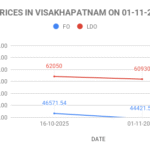Superior Kerosene Oil (SKO)
What is Superior Kerosene Oil (SKO)
Superior Kerosene Oil (SKO) is kerosene. SKO is a middle distillate mixture of hydrocarbons. SKO composition and quality are defined by specifications set by the Central Government of India in consultation with the Bureau of Indian Standards (BIS). These specifications ensure the consistent quality and safe use of SKO across various applications.
Superior Kerosene Oil (SKO) – USES
SKO is a versatile petroleum product. SKO is utilized in several industrial and domestic applications. SKO is an effective heating and burning properties. Some of its primary uses include:
Heating: SKO is commonly used in space heaters and furnaces. SKO is used for residential and industrial heating.
Cleaning: It serves as a solvent in cleaning applications. SKO is used in industrial settings where strong solvents are required.
Lighting: SKO is used as a fuel in lamps and lanterns. SKO provides a reliable source of light in areas without electricity.
Cooking: SKO is used as a cooking fuel in stoves.
Drying: SKO is employed in processes requiring controlled drying. SKO is used in certain manufacturing operations.
Thinner: SKO is used as a thinner for paints and other materials. SKO is aiding in achieving the desired consistency and application properties.
Superior Kerosene Oil (SKO) – Distribution and Sensitivity
Superior Kerosene Oil is one of the sensitive petroleum products distributed through the Public Distribution System (PDS) in India. The PDS ensures that essential commodities including SKO are available to the public at subsidized rates. SKO is accessible to economically weaker sections of society. The SKO sensitivity lies in its critical role in everyday life. SKO economic impact on households and industries relying on it for various applications.
Superior Kerosene Oil (SKO) – Density and Energy Content
The density of Superior Kerosene Oil is a crucial parameter influencing its performance and energy content. SKO has a density of 0.7782 kg/Litre. Its energy content is significant, providing 11,110 kilocalories (kcal) per kilogram, which underscores its efficiency as a fuel for heating, lighting, and other applications.






